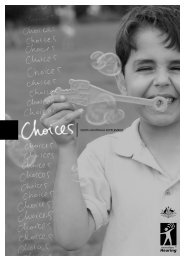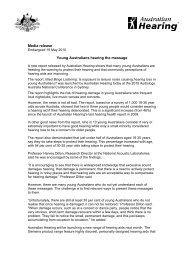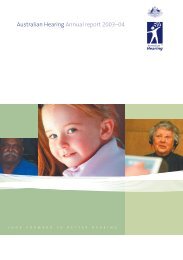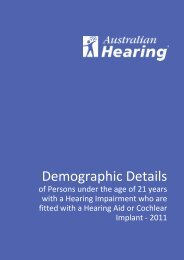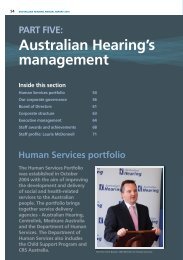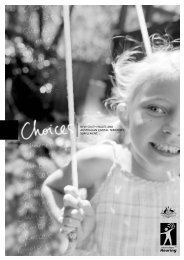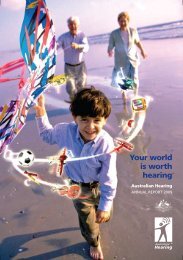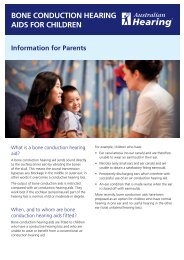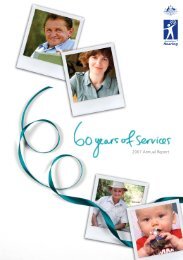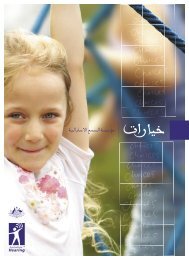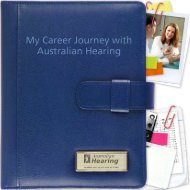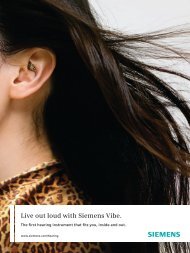Part Two: Australian Hearing in the community
Part Two: Australian Hearing in the community
Part Two: Australian Hearing in the community
You also want an ePaper? Increase the reach of your titles
YUMPU automatically turns print PDFs into web optimized ePapers that Google loves.
<strong>Part</strong> <strong>Two</strong>: <strong>Australian</strong> <strong>Hear<strong>in</strong>g</strong> <strong>in</strong> <strong>the</strong> <strong>community</strong><br />
29<br />
Services for<br />
Indigenous adults<br />
Aborig<strong>in</strong>al and Torres Strait Islander<br />
adults are eligible for free hear<strong>in</strong>g<br />
services if <strong>the</strong>y are aged over<br />
50 years or if <strong>the</strong>y are a current<br />
participant <strong>in</strong> a Community<br />
Development Employment<br />
Project (CDEP), or participated <strong>in</strong><br />
a CDEP <strong>in</strong> <strong>the</strong> period between<br />
1 December 2005 and 30<br />
June 2008. Collectively, <strong>the</strong>se<br />
groups are known as Indigenous<br />
Eligibility (IE), and are funded<br />
through <strong>the</strong> CSO program.<br />
Dur<strong>in</strong>g 2008/09, we provided<br />
hear<strong>in</strong>g services to 1,947<br />
adults aged over 50 and 579<br />
adults participat<strong>in</strong>g <strong>in</strong> CDEP<br />
at a permanent or visit<strong>in</strong>g<br />
site, or outreach site.<br />
Graph Three on page 28 shows<br />
<strong>the</strong> number of clients seen s<strong>in</strong>ce<br />
<strong>the</strong> change to eligibility was<br />
<strong>in</strong>troduced on 1 December 2005.<br />
The number of clients seen has<br />
<strong>in</strong>creased steadily over this period.<br />
We also saw a fur<strong>the</strong>r 272<br />
Indigenous adults <strong>in</strong> 2008/09<br />
who met o<strong>the</strong>r eligibility criteria.<br />
Services for<br />
Indigenous children<br />
We saw a total of 5,372<br />
Indigenous children dur<strong>in</strong>g<br />
2008/09, <strong>in</strong> urban, rural and<br />
remote ma<strong>in</strong>stream and outreach<br />
sites. This represents 18.7 per cent<br />
of <strong>the</strong> total number of children and<br />
young adults who received hear<strong>in</strong>g<br />
services <strong>in</strong> 2008/09. Most recent<br />
census data (2006) estimates<br />
that 2.5 per cent of <strong>Australian</strong>s<br />
identify as be<strong>in</strong>g Aborig<strong>in</strong>al, Torres<br />
Strait Islander or both. In view of<br />
<strong>the</strong> known prevalence of hear<strong>in</strong>g<br />
health problems <strong>in</strong> <strong>the</strong> Indigenous<br />
<strong>community</strong>, we expected to<br />
see an over-representation of<br />
Aborig<strong>in</strong>al and Torres Strait<br />
Islander children compared to<br />
<strong>the</strong> non-Indigenous population.<br />
Table Three (below) shows <strong>the</strong><br />
breakdown of Indigenous children<br />
and young people fitted with<br />
hear<strong>in</strong>g aids by State and Territory<br />
for <strong>the</strong> calendar year 2008.<br />
Streng<strong>the</strong>n<strong>in</strong>g<br />
partnerships with<br />
communities and agencies<br />
Our Indigenous Liaison Officers,<br />
outreach audiologists and program<br />
coord<strong>in</strong>ators promote our services<br />
and build and ma<strong>in</strong>ta<strong>in</strong> relationships<br />
with Aborig<strong>in</strong>al and Torres Strait<br />
Islander communities and clients.<br />
As a result, we provide hear<strong>in</strong>g<br />
services through Indigenous<br />
<strong>community</strong> controlled health<br />
services, <strong>community</strong> organisations,<br />
and ma<strong>in</strong>stream cl<strong>in</strong>ics and schools.<br />
Interested communities identify <strong>the</strong>ir<br />
hear<strong>in</strong>g health needs, and hear<strong>in</strong>g<br />
services are negotiated based on<br />
this. As part of this process, we are<br />
document<strong>in</strong>g <strong>the</strong> outcome of <strong>the</strong>se<br />
discussions <strong>in</strong> service agreements,<br />
which describe <strong>the</strong> framework and<br />
responsibilities of <strong>the</strong> program.<br />
A review of <strong>the</strong> program takes<br />
place as required or annually.<br />
We are work<strong>in</strong>g with Queensland<br />
Health’s ‘Deadly Ears’ program,<br />
<strong>the</strong> <strong>Australian</strong> Government<br />
Intervention <strong>in</strong> <strong>the</strong> Nor<strong>the</strong>rn<br />
Territory and o<strong>the</strong>r state-funded<br />
health services to ensure that<br />
primary and tertiary hear<strong>in</strong>g health<br />
services complement each o<strong>the</strong>r.<br />
We saw a total of 5,372<br />
Indigenous children dur<strong>in</strong>g<br />
2008/09, <strong>in</strong> urban, rural<br />
and remote ma<strong>in</strong>stream<br />
and outreach sites.<br />
Table Three: Aborig<strong>in</strong>al and Torres Strait Islander children<br />
fitted with hear<strong>in</strong>g aids by State and Territory<br />
NSW Vic Qld WA SA Tas ACT NT TOTAL<br />
98 33 552 164 66 1 3 384 1,301



